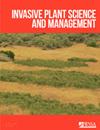The use of a herbicide as a tool to increase livestock consumption of medusahead (Taeniatherum caput-medusae)
IF 1.2
4区 生物学
Q3 PLANT SCIENCES
引用次数: 1
Abstract
Abstract Medusahead [Taeniatherum caput-medusae (L.) Nevski] is an invasive annual grass spreading into rangelands throughout the western United States. We tested cattle (Bos taurus L.) utilization of T. caput-medusae following treatment with glyphosate in two forms of its salt (potassium salt and isopropylamine salt) at three different rates of application; low (236 g ae ha-1), medium (394 g ae ha-1), and high rates (788 g ae ha-1) in eastern Washington. The herbicide was applied on April 26, 2016. A second location, northern Utah, was treated with glyphosate in the form of its isopropylamine salt at the high rate. The herbicide was applied on June 5, 2019. Cattle were allowed to start grazing T. caput-medusae 15 d after glyphosate treatment and had unlimited access to the glyphosate-treated plots for more than 85 d. The greatest utilization of T. caput-medusae occurred at the highest glyphosate application rate (P < 0.05), in Washington, with no difference between forms of glyphosate salt. Cattle also consumed T. caput-medusae at the Utah site (P < 0.05). Glyphosate treatment preserved the water-soluble carbohydrate content of T. caput-medusae at levels greater than the nontreated controls (P < 0.05) at both locations. The glyphosate treatment assisted in the increased utilization of T. caput-medusae by cattle and is a viable option for the reduction of T. caput-medusae while increasing the forage value of the weed.一种除草剂的使用,作为一种工具,以增加medusahead (Taeniatherum capt -medusae)的牲畜消费量
Medusahead [Taeniatherum caput-medusae (L.)]是一种侵入性的一年生草,遍布美国西部的牧场。在三种不同的施用量下,以两种形式的草甘膦盐(钾盐和异丙胺盐)处理牛(Bos taurus L.)后,测试了牛(Bos taurus L.)对T. capt -medusae的利用情况;华盛顿东部低(236 g / ha-1)、中(394 g / ha-1)和高(788 g / ha-1)。该除草剂于2016年4月26日施用。第二个地点,犹他州北部,以异丙胺盐的形式用草甘膦进行了高速率处理。该除草剂于2019年6月5日施用。草甘膦处理后15 d允许牛开始放牧,85 d以上允许牛无限制进入草甘膦处理地块。华盛顿地区草甘膦施用量最高,对草甘膦的利用率最高(P < 0.05),不同形式的草甘膦盐没有差异。犹他地区的牛也食用了墨杜莎金针菇(P < 0.05)。草甘膦处理能显著提高毛蚶水溶性碳水化合物含量(P < 0.05)。草甘膦处理有助于提高牛对美杜鹃的利用,是减少美杜鹃数量同时提高其牧草价值的可行选择。
本文章由计算机程序翻译,如有差异,请以英文原文为准。
求助全文
约1分钟内获得全文
求助全文
来源期刊

Invasive Plant Science and Management
PLANT SCIENCES-
CiteScore
2.20
自引率
9.10%
发文量
24
审稿时长
6-12 weeks
期刊介绍:
Invasive Plant Science and Management (IPSM) is an online peer-reviewed journal focusing on fundamental and applied research on invasive plant biology, ecology, management, and restoration of invaded non-crop areas, and on other aspects relevant to invasive species, including educational activities and policy issues. Topics include the biology and ecology of invasive plants in rangeland, prairie, pasture, wildland, forestry, riparian, wetland, aquatic, recreational, rights-of-ways, and other non-crop (parks, preserves, natural areas) settings; genetics of invasive plants; social, ecological, and economic impacts of invasive plants and their management; design, efficacy, and integration of control tools; land restoration and rehabilitation; effects of management on soil, air, water, and wildlife; education, extension, and outreach methods and resources; technology and product reports; mapping and remote sensing, inventory and monitoring; technology transfer tools; case study reports; and regulatory issues.
 求助内容:
求助内容: 应助结果提醒方式:
应助结果提醒方式:


